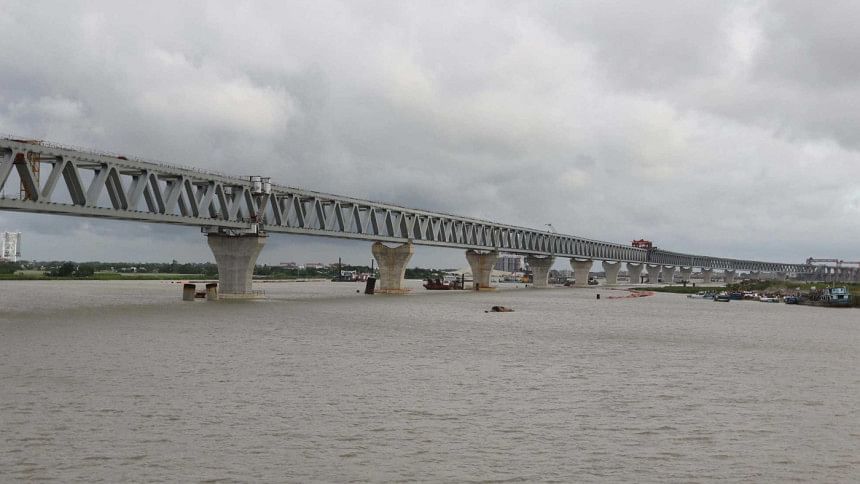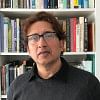Padma Bridge is a metaphorical countermovement

Recently, on a wintry afternoon, I went to see the Padma Bridge. I experienced something unique. Whether you are standing on the bank of the mighty Padma or on a boat in the water looking straight ahead, the bridge gradually fades into an infinite line—or perhaps into the future. It was both magical and mystical.
I have seen great river bridges before: Florence's Ponte Vecchio, New York's Brooklyn Bridge, San Francisco's Golden Gate Bridge, Sydney's Harbour Bridge, and London's Tower Bridge. All are civic monuments and urban icons of these cities. What is so special about the Padma Bridge?
I must confess, seeing it for the first time felt a bit unreal or even surreal—a technological behemoth poetically upending the tranquillity of rural Bengal. Our soft mental image of pastoral Bengal—characterised by paddy fields, rivulets, homesteads, ponds, humble scale of things, and solitude—is challenged by the bridge's godlike scale, cutting-edge technology, and futurist ambition.
I wondered how technology could conquer the legendary Padma River with such ease and simplicity. The bridge seemed like a line that hovers over the river with a magisterial sweep. When a colossal piece of engineering enters a pristine natural landscape, it may perturb our cherished mental images of familiar rivers, places, and geographies. As much as they are natural phenomena, rivers are also epics etched on geography that only the mind can process. Manik Bandopadhyay's Padma has no giant bridge over it—only the perennial flow of water, and the majhis who find inspiration in it for their survival. A mammoth bridge does not seem compatible with Tagore's depiction of the Padma, "Idly my mind follows the sinuous sweep of the Padma roaming under a distant sky."
How did I process the unlikely juxtaposition of my own mental image of the Padma River, and an engineering marvel that tames it?
A mystical veneration, a mix of spirituality and dread, attended my experience of the Padma Bridge. Philosophers have discussed the psychological effects of a "sublime" feeling. For British political thinker Edmund Burke, the sublime, unlike the "beautiful," could evoke an exalted emotional quality of attraction and fear. The sublime is grand and dangerous. German philosopher Immanuel Kant argued that the sublime has to do something with the awe-inspiring scale and boundlessness of a phenomenon. In front of an ocean or a mountain, one could feel his or her insignificance, experiencing a sublime feeling.
In the 20th century, American theorists like Perry Miller and later David Nye used the concept of "technological sublime" to explain how technology's provocation of ecstasy, bewilderment, and terror played an important role in shaping the modern American mind. Standing before the gigantic concrete superstructure of Hoover Dam, built on the Colorado River during the 1930s, I understood what technological sublime meant: a complex mix of wonder, admiration, and fear.
The Padma Bridge is, I believe, Bangladesh's maiden example of technological sublime. Standing awed in front of it, I wondered how it would reshape our political consciousness, transform our cultural universe, and disrupt our understanding of a deltaic geography. Its sheer scale and innovation should not overwhelm us to not consider its practical value. The multipurpose bridge is 6.15km long, with a four-lane highway on the upper level and a single-track railway on the lower level. When completed, it will be one of the longest river crossings in the world. And, when the bridge reaches its full capacity, 75,000 vehicles will cross it every day, increasing the GDP of the impoverished south-west region Bangladesh by up to 2.5 percent. With the contribution of the bridge, national GDP is projected to rise by 1.2 percent. Furthermore, as research shows, every taka spent on the bridge is expected to generate about Tk 2 of social good. This is a huge boost for the national economy and the country's collective well-being.
But beyond the engineering accomplishment of the Padma Bridge and its economic promises, what are its larger social and cultural meanings? Is it merely a bridge that would boost connectivity and economic productivity? What does the bridge mean culturally, socially, and politically for Bangladesh?
First, the underlying motivation for national confidence-building has been obvious. Since the World Bank withdrew its funding for the project in 2012 over the allegation of corruption, there has been a national outrage, steeped in a postcolonial, nativist grievance against the "civilising mission" of Western powers. Self-funding and constructing the bridge became the symbolic catalyst for graduating the country from the infamous "basket case" to a self-confident nation, assertive on the world stage. The bridge was Bangladesh's message to the world: The era of West-to-East, North-to-South political pontification is over.
Second, the bridge symbolises a direction opposite to that of the Indian subcontinent's power diffusion along the Ganges-Padma river system. Rising in the Himalayas, the Ganges flows from northwest to southeast, entering Bangladesh at the northern edge of the Kushtia district. It then streams through the heart of the Bengal delta, eventually emptying into the Bay of Bengal. This Gangetic trajectory has been the migratory path of Vedic Brahmins, invaders, occupiers, dynastic rulers, military strongmen, traders, saints, and power-wielders to the Indian subcontinent. From Indo-Aryans and the Mauryas to the Mughals and colonial powers, all followed this path to arrive in Bengal. This is the direction through which the frontier advanced from northwestern power centres to southeastern Bengal's agrarian hinterlands. In 1204, Muhammad Bakhtiyar's Turkish cavalry followed this path. Mughal Subahdar Islam Khan Chishti arrived in Dhaka following this riverine trail. West Pakistan sought to control the political destiny of the people of East Pakistan. The symbolism of that power trajectory persists.
The Padma Bridge is a metaphorical countermovement—politically conceived to set in motion a new frontier to advance from southeast to northwest and southwest. It is an emblematic defiance of and resistance to the historical Gangetic trajectory and, by extension, the West. It symbolises a reversal of a power arc that has traditionally defined the political structures and their diffusion in the Indian subcontinent. The bridge is a new geostrategic gesture from East to West—a resistive message from the Global South to the Global North about a shifting global power dynamic.
Finally, as much as it is about strengthening communications with southwest Bangladesh and eliminating the time-consuming ferry-crossing of the Padma River, the bridge is also about us. It hints at our anxieties and aspirations, and our fractious visions for the future. As we build the bridge, we mitigate our geo-cultural vulnerabilities and celebrate our national advancements. We use the bridge as a mental backdrop for projecting our green-and-red patriotic exaltations. The Padma Bridge is the spatialisation of our national aspirations and a personification of the Bengali self. In this sense, I find a lot of similarities between the National Martyrs' Memorial at Savar and the Padma Bridge. Both are monuments to our national consciousness.
As I walked on the bridge, I felt both euphoric and melancholic. Euphoric because the bridge has conquered a sea-like river, recalibrating the hydrogeography of Bangladesh for the 21st century, thanks to Prime Minister Sheikh Hasina's steadfast determination. Melancholic because in crossing the bridge in the comfort of a car or a bus in a few minutes, we may lose the psychological connection to the waters of the Padma River that has animated artists, poets, novelists, boatmen, fishermen, and many other protagonists. I always thought that crossing a river by a boat had a spiritual dimension. You are in the water, not over it.
But people are never stagnant. They move on and adapt to new realities. The technological sublimity of the Padma Bridge perhaps would inspire new types of cultural imaginations and geographic consciousnesses. Most importantly, the bridge will improve the social and economic lives of southwestern Bangladesh. That's a great thing.
Adnan Zillur Morshed is a professor, architect, architectural historian, and urbanist. He teaches in Washington, DC, and serves as the executive director of the Centre for Inclusive Architecture and Urbanism at Brac University.

 For all latest news, follow The Daily Star's Google News channel.
For all latest news, follow The Daily Star's Google News channel. 



Comments